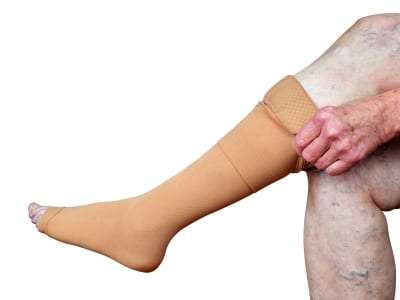 Vein disease is very common. It develops when the valves within the veins do not work properly, allowing blood to flow backward away from the heart. As a result, blood can pool in veins and cause conditions such as spider vein, varicose veins, and blood clots.
Vein disease is very common. It develops when the valves within the veins do not work properly, allowing blood to flow backward away from the heart. As a result, blood can pool in veins and cause conditions such as spider vein, varicose veins, and blood clots.
What is a Vein?
Veins are thin-walled, tiny tube-like structures that carry blood back to the heart.
The heart pumps oxygen-rich blood to all body tissues through thicker-walled arteries, and the veins return the blood to the heart. Veins are equipped with valves to keep blood flowing in one direction (i.e., flowing back to the heart) and preventing gravity from allowing blood to flow in the reverse direction.
Veins in the human body are translucent. A vein’s color appearance is determined in large part by the color of the blood, usually dark red, as a result of its low oxygen content.
A vein’s color is affected by the characteristics of a person’s skin, how much oxygen is in the blood, the size of the vein, and how deep the vessel is in the body. However, veins appear blue because the skin absorbs low-frequency light, permitting only the highly energetic blue wavelengths to penetrate through to the dark vein and reflect back to the viewer.
Veins are different from arteries. Arteries are under greater pressure as blood is pumped from the heart, which is felt as a “pulse.” Because of this pressure, the walls of the arteries are much thicker than those of veins. Arteries also tend to have a more uniform, round shape than veins.
What are Diseases of the Veins?
When the vein walls become damaged, the circulatory system is hindered. Blood is allowed to collect and flow in a retrograde (backward, away from the heart) fashion when the muscles relax. This creates an unusually high-pressure buildup in the veins, causing the veins to stretch, twist, and swell, resulting in sluggish blood flow and the potential formation of a blood clot. Eventually, the condition can lead to various disorders known as venous disease.
Venous disease is quite common, affecting millions of people each year. It causes conditions like varicose veins, which do not generally pose a great health risk. However, inflammation (thrombophlebitis) can be much more serious, even life-threatening.
Vascular pain often feels like a heaviness in the affected area. It can cause numbness, weakness, or tingling in the affected area.
Some venous insufficiencies and diseases include:
- Blood Clots. A condition that slows the flow of blood and causes the blood to form a semisolid mass (clot).
- Deep vein thrombosis. A condition in which a blood clot forms in a deep vein, usually in the legs. It can cause the affected limb to swell, and cause pain and an overlying skin rash.
- Edema (Swelling). An abnormal accumulation of fluid in the body tissues.
- May-Thurner Syndrome. A type of vein disease that can lead to deep vein thrombosis.
- Nighttime Leg Cramps. A painful, involuntary contraction or spasm in the muscles of the legs, sometimes called a “Charley Horse.”
- Orthopedic Leg Pain. Any vascular condition that causes pain in the legs.
- Pelvic Congestion. Similar to varicose veins, a condition that affects the veins of the pelvis, most common in women.
- Restless Leg Syndrome (RLS). A common, treatable neurological disorder causing an irresistible urge to move the legs.
- Spider Veins. A mild form of varicose veins that results in the dilation of a group of small blood vessels.
- Stasis Dermatitis. Discoloration of the skin that develops when there is poor blood circulation and causes a buildup of fluid in the legs. It can lead to a change in skin color and open sores.
- Varicose Veins. Enlarged, swollen, and twisted veins near the surface of the skin that allow blood to flow backward or stagnate within the vein.
- Venous Insufficiency. A condition in which the vein walls or valves don’t work correctly, making it difficult for blood to be pumped back to the heart.
- Venous Ulcers. A slow-healing skin sore, usually due to problems with blood circulation, most often in the legs.
Diagnosis of Vein Disease
Venous disease is diagnosed by a physical examination and a study of the patient’s medical history. However, some conditions like varicose veins can be diagnosed by observation.
A duplex ultrasound is the standard diagnostic test for the evaluation of varicose veins. However, other imaging tests to determine blood flow and the structure of the veins include:
- Venography. The use of X-rays after a contrast medium is injected into the veins to highlight them.
- Duplex Ultrasound. An exam that allows viewing of the efficiency of veins returning blood to the heart, which is also used to detect blood clots in the legs.
- Computed Tomography (CT) scan. A computer-processed combination of many X-ray images taken from different angles to produce cross-sectional images of veins.
- Magnetic Resonance Imaging (MRI). A type of radiology using strong magnetic fields and radio waves to generate images.
What are Vein Treatment Options?
Some tips for treating venous disease at home include:
- Elevate the feet. During the day, keep the feet level with the hips. At night, raise the foot of your bed from two to four inches to help aid circulation while sleeping.
- Compression Therapy (support stockings). A simple and effective means of increasing blood flow in the lower limbs by strengthening vein support with gentle pressure to help prevent blood from pooling in the veins.
- Bed rest and elevation of the affected limb are essential for patients with deep-vein thrombophlebitis; however, some patients may require hospitalization.
- Anti-clotting medication or Clot-Dissolving agents may be administered to help resolve some conditions.
Other medical procedures are available depending on the condition being treated:
- Endovenous Ablation. A minimally invasive procedure using laser energy, radiofrequency, or steam to cauterize and close varicose veins.
- Phlebectomy. A minimally invasive procedure using a small scalpel or needle to remove varicose veins that lie just beneath the surface of the skin.
- Sclerotherapy. A minimally invasive procedure of injecting a solution (a sclerosant) directly into a varicose or spider vein which causes the vein to disappear slowly.
- VenaSeal. A treatment for venous reflux disease. It is the only non-thermal, non-sclerosant procedure approved by the FDA in treating diseased veins.
- RF ClosureFAST. A procedure using radiofrequency energy to treat varicose veins and other chronic venous diseases.
Is it Possible to Prevent Vein Disease?
It is recommended that you call your doctor if you experience a painful, swollen vein that does not disappear in a few days, or if you have unexplained swelling in an arm or leg.
Tips to help prevent venous disease include:
- Walking.
- Controlling weight.
- Wearing low-heeled shoes.
- Avoiding long periods of sitting or standing in one position.
- Stand up and walk around often during long airplane or automobile trips.
- Following a heart attack or major surgery, it is essential to walk as soon as allowed by your doctor to help avoid problems.
The Novus Spine & Pain Center Vein Clinic offers a wide range of approaches to treat the complete spectrum of vascular conditions. We emphasis minimally invasive techniques that can be performed conveniently in the comfort of our office.
Novus Spine & Pain Center
The Novus Spine & Pain Center is in Lakeland, Florida, and specializes in treating chronic pain. By using a comprehensive approach and cutting-edge therapies, we work together with patients to restore function and regain an active lifestyle, while minimizing the need for opiates.
Our Mission Statement: To provide the best quality of life to people suffering from pain, by providing state of the art treatments, knowledge and skill, compassion, and respect for all.
To schedule an appointment, please contact us online, request a call back, or call our office at 863-583-4445.
Vein Disease Resources
Vein (Wikipedia)
Venous Disease (Johns Hopkins)
Vascular Diseases and Pain (WebMD)
Vein Clinic (Mayo Clinic)

